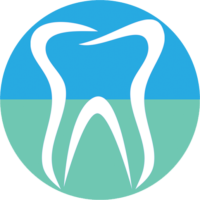The absence of teeth distorts facial aesthetics and leads to functional difficulties. The remaining teeth tend to bend to the empty space, there is a rotation around the longitudinal axis of the tooth as well as a “resurfacing” in the opposite field in the edentulous jaw. Edentulous spaces do not support for the soft structures of the mouth (cheeks, lips) any more, which causes them to “fall” creating deep furrows between the nose and corners of the mouth (aged facial appearance). The loss of teeth also causes a breakdown in the interrelationship between the jaws and this can result in pain in the temporomandibular joint.
All prosthetics are made in our dental technology, state of the art CAD-CAM technology.
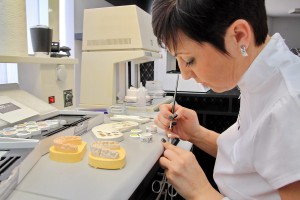
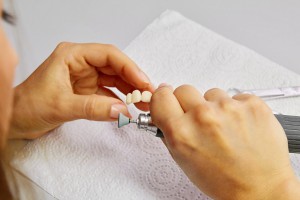
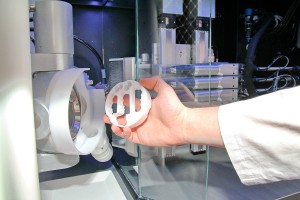
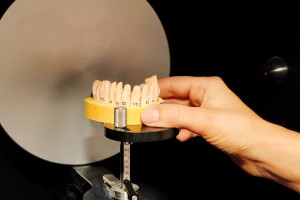
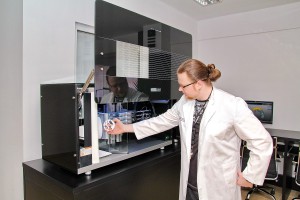
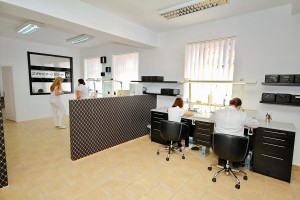
Therefore the missing teeth need to be to compensated with the appropriate prosthetic devices, which can be either fixed (not removed from the mouth), mobile or combined.
Fixed appliances are crowns and bridges, while the mobile (removable) appliances include full or partial dentures.
Fixed dentures
CROWNS
CROWNS are prosthetics that make up the lost tooth structure and imitate natural teeth in shape, size and color. They look like caps that are glued to the tooth.
Crowns are needed when:
- a great part of the tooth is lost due to breakage or high caries lesion
- there are bigger fillings in the tooth and there is a danger of breaking of the other parts of the tooth
- the patient is not satisfied with the look and position of their teeth
- teeth are naturally broken away as the result of aging (abrasion)
- the tooth is devitalized (extracted from its nerves) and reinforced with fiberglass pin
The process of putting on a crown is conducted by a dentist and a dental technician, and the process is the following:
- After the examination, in consultation with the patient, the treatment plan is done and the teeth where the crowns are put are determined.
- Under local anesthesia, teeth are shaped (they are reduced the volume in all dimensions)
- otisnom masom u kašici uzme se otisak izbrušenih zuba i zuba suprotne vilice i pošalje u tehniku
- An impression is taken from the opposite jaw and the print is sent to the laboratory
- The dental technician, according to the case and materials which the crowns are made of, prepares one or more rehearsals and in consultation with the patient and the doctor determines the color of the crown.
- Fixed crowns are cemented in the mouth of the patient (in case of making crowns on implants, the prosthetic process starts with the third point)
In relation to the material they can be made of crowns can be metal-free ceramic or ceramic crown on a metal or zirconium basis.
Metal – free ceramic crowns
With the all-ceramic crowns superior esthetic results can be achieved, primarily due to the transparency of the material, which lets through light rays just the way teeth do. The crown requires very precise preparation of teeth and flawless image, so that dental technicians can make this type of crown using microscopes.
Metal – ceramic crowns
A classical and most commonly used crown is the metal-ceramic crown, thanks to its good mechanical properties and acceptable aesthetic. The base of crowns makes the alloy layer where the ceramic is put. The disadvantage of these crowns is observed during the withdrawal of the gums, when the metal edge becomes visible, or more often to prove an allergy to alloys.
Zirconium crowns
The most modern material for making crowns is the zirconium oxide. Exceptional strength and aesthetic properties are a big advantage of zirconium crowns over metal-ceramic ones, as well as better insulation and reduced irritation of the polished teeth. Due to the absence of allergic reactions it is the material of choice to sensitive persons.
Bridges
Bridges are fixed dental restorations, which consist of several connected crowns and “bridge” the toothless spaces in the jaws. In cases where the patient is missing one or more teeth, bridges are made.
The procedure of putting on a bridge is the same as in case of putting on crowns. The dentist polishes the teeth which are going to be holders of the bridge, takes a print and the dental technician makes the bridge. Holders of the bridge can be: existing teeth, implants or the combination of these.
After cementing, the patient needs to maintain adequate oral hygiene. Besides the toothbrush and toothpaste, the use of the following is recommended:
- Interdental brushes
- Specific dental floss for cleaning the space between the gums and the bridge
- An electric device which cleans the space between the crowns under the pressure of a water jet
The selection of dental restorations depends on several factors, primarily the number, distribution, and periodontal status of the remaining teeth, and the condition of toothless space and mucous membranes. Priority should always be given to solutions to prosthetic implants, and preferably fixed works. The advantages of bridges over dentures:
- They are attached to the holder teeth and they cannot be removed from the teeth
- compressive forces during chewing are transmitted to the tooth (as with natural teeth) and not the surrounding soft tissue
- better aesthetics can be achieved
- no parts of the restorations can be found on the palate, under the tongue or on any other soft structure
- the functions of speech and chewing work the same way as in case of natural teeth
- patients quickly get adapted to the changes
Removable dentures
Mobile compensation, known as dentures are removed from the patient’s mouth. We divide them into full and partial dentures.
FULL DENTURES
Full dentures are made when all the teeth are missing from the jaw.
Total plate dentures are made from acryl and, if necessary, can be reinforced with a metal base or grid. If the patient is allergic to acryl, should we opt for making a crystal prosthesis, which does not contain acryl, extends the plate dentures in other characteristics, and is well proved as a full and partial denture.
In case of complete dentures chewing forces are transmitted non-physiologically through the gums, and whenever possible, implants should be incorporated because dentures on implants are the best in physiological, functional and aesthetic aspects, and give patients the best and most secure feeling. They are reduced and, thanks to the implants, stand firm.
PARTIAL DENTURES
Partial dentures compensate one or more teeth (not all) and are made when in some reasons fixed dentures cannot be made.
Partial plate dentures are made from acryl and belong to temporary dentures because in at least five years they should be changed. The transmission of chewing forces is also non-physiological, the permanent teeth are unequally oppressed, and the wire hooks damage the teeth in the sense of the appearance of caries. In size they are much larger and thicker than other types of partial dentures so that it is more difficult for the patients tend to adapt to them.
For these reasons today the dentures made from modern materials hold more important places: valplast, biodentaplast, flexiplast and partial skeleton dentures.
